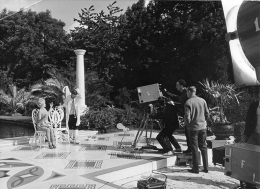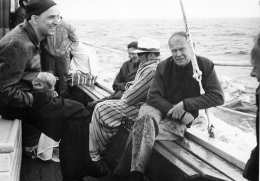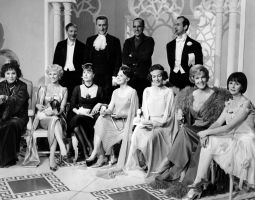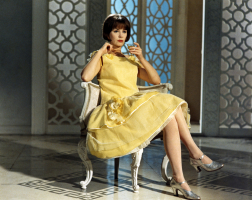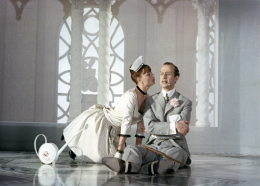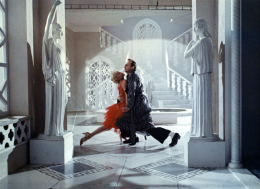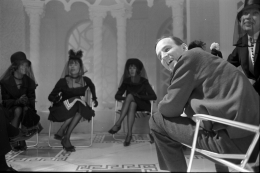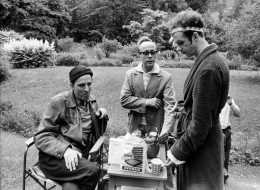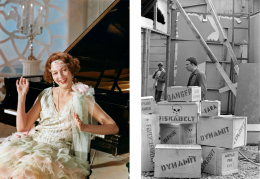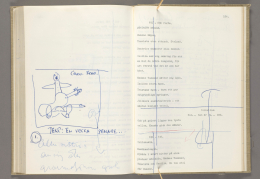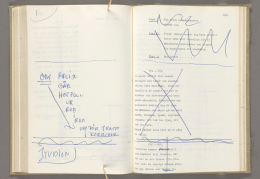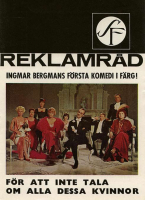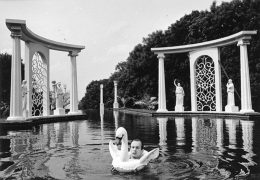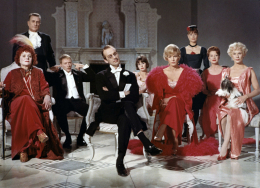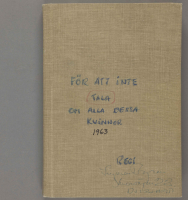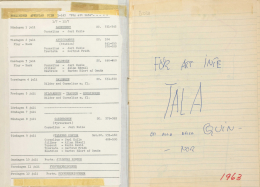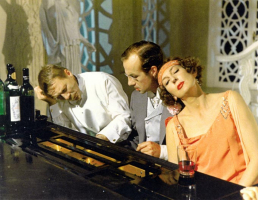All These Women
When a famous cello virtuous dies his following of beauitful women go into mourning and his biographer has a change of plans.
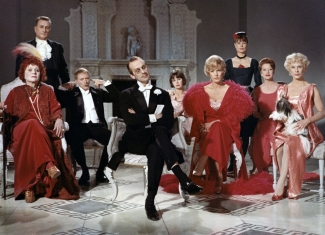
"[I]t is of interest when a director of genius moves from art to trickery, from the artistic to the quirky. Yet one may confidently state that it is the most indifferent, in the sense of being the least absorbing, film he has created."Gunnar Unger in Svenska Dagbladet
About the film
Ingmar Bergman's first colour film is a light-hearted comedy co-written with actor Erland Josephson. The film revolves around the critic Cornelius – Jarl Kulle playing one of his many Don Juan characters – who is writing a biography of the famous cello virtuous Felix. When the grand artist dies his following of beauitful women go into mourning and Cornelius has a change of plans.
Bergman writing on the genesis of the film in Images: My Life in Film:
'All These Women had been made solely in order to earn money for Svensk Filmdustri. That it became great, calculated gimmick from beginning to end is another story. In the The Magic Lantern, I wrote: 'Sometimes considerably more courage is required to put on the brakes than to fire the rocket. I lacked this courage and realized, only too late, what kind of film I should have made.'
Around this period, Bergman was involved with a 'Colour Film School', which had already resulted in The Pleasure Garden, and other projects. He and his team carried out various experiments prior to settling on the colour scale for All These Women. However, it is quite possible that Bergman's disappointment with the results, combined with the lukewarm reception given to the film by the critics, was a contributing factor to why several years were to pass before he would once again venture into colour. Even as late as 1976 he was considering shooting The Serpent's Egg in black and white.
Sources
- The Ingmar Bergman Archives.
- Ingmar Bergman, Images: My Life in Film.
Press reactions to the film were almost uniformly cool and negative. The critics were equally dismissive when it was subsequently screened at the Venice Film Festival. It was only later, and then chiefly in France, that the film attracted any degree of positive attention.
Gunnar Unger in Svenska Dagbladet:
One's final impression is that the new Bergman film, despite many excellent details, despite (Jarl) Kulle's brilliant one-man show the others are more or less extras, but what extras!, is laboured and pretentious. It would be absurd to say that it is Bergman's worst film; he and his extraordinary team of actors and technicians are incapable of making a bad film. Neither could one say that it is his least interesting; it is of interest when a director of genius moves from art to trickery, from the artistic to the quirky. Yet one may confidently state that it is the most indifferent, in the sense of being the least absorbing, film he has created.
"A genius is a person who can get a critic to change his mind, according to an old adage of the cinema. If Ingmar Bergman can get the critics and posterity to alter their view of this summer's offering at the Röda Kvarn cinema then his talent, the one which has temporarily gone to sleep, definitely belongs on the Mount Olympus of genius."
Jurgen Schildt in Aftonbladet
"The film's fatal flaw is that it is seldom amusing. It has a number of witty lines in which Bergman's irony shines though. But it is totally without humour. It is over elaborate with its fussy décor of lattice work and Moorish arches; the colours are cold in tone – as is the film in general."
Mauritz Edström in Dagens Nyheter
"Ingmar Bergman's new film All these Women is one of the most peculiar comedies one has ever seen. For me it was a disappointment and, to put it bluntly, so boring that it was a great effort to see it through to the end."
Nils Beyer in Stockholms-Tidningen
Distribution titles
À propos de toutes ses femmes (France)
Ach, diese Frauen (West Germany)
Esas mujeres (Spain)
Toutes ses femmes (France)
Production details
Production country: Sweden
Swedish distributor (35 mm): Svensk Filmindustri, Svenska Filminstitutet
Laboratory: FilmTeknik AB
Production company: Svensk Filmindustri
Aspect ratio: 1,37:1
Colour system: Eastman Color
Sound system: Optical mono
Original length (minutes): 80
Censorship: 102.029
Date: 1964-05-28
Age limit: 15 years and over
Length: 2195 metres
Release date: 1964-06-15, Röda Kvarn, Stockholm, Sweden, 80 minutes
Filming locations
Sweden
Filmstaden, Råsunda
The gardens of Norrviken, Båstad
Music
Title: Yes! We Have No Bananas Alternative title: Vi har inga bananer
Composer: Frank Silver (1923) Irving Conn (1923)
Lyrics: Frank Silver (English lyrics 1923) Irving Conn (English lyrics 1923) Karl Gerhard (Swedish lyrics 1923)
Arrangement: Charles Redland
Title: Suite, orchestra, no 3, BWV 1068, D major. Air Alternative title: Air on the G-string
Composer: Johann Sebastian Bach (1729?)
Comment: Instrumental.
Title: Suite, no 3, d minor
Composer: Johann Sebastian Bach
Comment: Instrumental.
Title: Adelaide, op. 46
Composer: Ludwig van Beethoven (1795)
Lyrics: Friedrich Matthisson
Singer: Jarl Kulle
Title: La belle Hélène Alternative title: Den sköna Helena
Composer: Jacques Offenbach (1864)
Lyrics: Henri Meilhac (French lyrics 1864) Ludovic Halévy (French lyrics 1864) Palle Block (Alias) (Swedish lyrics 1865)
Comment: Instrumental.
Title: Thaïs. Meditation
Composer: Jules Massenet (1894)
Comment: Instrumental.
James Quandt, 1996:
This was Bergman's first film in color, and he prepared for the transition with fastidious care. Set in the music world, the film is a satire about pompous males and the women who stroke their vanity while getting just what they want from them. A pretentious music critic visits the summer home of a renowned cellist who has just died. Intending to write the cellist's biography, the critic (as much a despised figure in Bergman as he is in Beckett) encounters a glittering phalanx of women who were the musician's "harem." Having put up with the virtuoso's infantilism, they now set about toying with the critic who seems to want to become the man he is writing about. The film is most notable for bringing together a sparkling ensemble of Bergman's favorite actresses who have a great time as "all these women".
Collaborators
- Jarl Kulle
- Bibi Andersson
- Harriet Andersson
- Eva Dahlbeck
- Karin Kavli
- Gertrud Fridh
- Mona Malm
- Barbro Hiort af Ornäs
- Allan Edwall
- Georg Funkquist
- Carl Billquist
- Jan Blomberg
- Göran Graffman
- Jan-Olof Strandberg
- Gösta Prüzelius
- Ulf Johanson
- Axel Düberg
- Lars-Erik Liedholm
- Lars-Owe Carlberg
- Doris Funcke
- Yvonne Igell
- P.A. Lundgren, Art Director
- Peter Wester, First Assistant Cameraman
- Lars Johnsson, First Assistant Cameraman
- Tage Sjöborg, Boom Operator
- Gerhard Carlsson, Gaffer
- Nils Nordling, Gaffer
- Svante Björklund, Gaffer
- Ivar Almér, Gaffer
- Wilhelm Almqvist, Gaffer
- Sven Nykvist, Director of Photography
- Ulla Ryghe, Film Editor
- Bertha Sånnell, Assistant Costume Designer
- Max Goldstein, Costume Designer
- Per-Olof Pettersson, Production Mixer
- Erland Josephson, Screenplay
- Olle Jakobsson, Re-recording Mixer
- Charles Redland, Music Composer
- Erik Nordgren, Music Composer
- Yngve Söderlund, Key Grip
- Gustav Wiklund, Key Grip
- Rune Håkansson, Key Grip
- Allan Ekelund, Production Manager / Production Coordinator
- Lenn Hjortzberg , Assistant Director
- Karl-Arne Bergman, Property Master
- Katinka Faragó, Script Supervisor
- Börje Lundh, Make-up Supervisor
- Britt Falkemo, Make-up Supervisor
- Cecilia Drott, Make-up Supervisor
- Evald Andersson, Sound Effects
- Harry Kampf, Still Photographer
- Ingmar Bergman, Screenplay
- P A Lundgren
